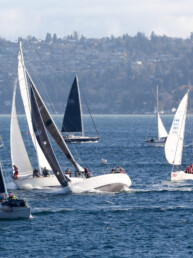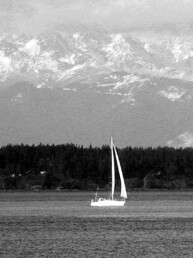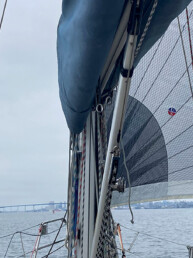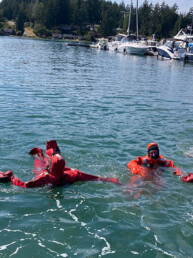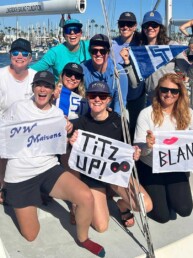How do you cut nearly two hours off a slow sailing trip from Seattle to the San Juan Islands?
Well, you could buy a new engine. Maybe get a super slick bottom paint job. Or just leave the boat at home and take the Victoria Clipper.
But the easier, cheaper, and far more fun solution is to play your currents right. And we have a pretty simple rule of thumb that will help make the relatively complex planning for that trip pretty simple.
Like a lot of cruisers, Deborah and I have been willing to cover more ground each day as our experience on the water has grown. . When we first started out, we figured four or five hours underway, max, was a comfortable amount for a day.
From our homeport on Elliott Bay, it is 62.8 nautical miles to get to Friday Harbor. So that first two-week trip to the San Juans needed to include at least two days to get up to the islands and two days to get back. That’s a big chunk of our cruising time that could otherwise be spent in the islands.
But with the addition of a reliable autopilot, and no shortage of binge-worthy podcasts to listen to, we soon discovered we could handle being underway for much longer stints. Six, 8, 12 hours, no problem. We could shove off from home and be up in our cruising grounds in time for an afternoon nap.
But this newfound stamina leads to more complex navigational challenges. A little background on tidal currents can help explain why. Tidal currents are caused by the massive flows of water that raise and lower sea levels during the daily high and low water tidal cycles. If you can travel in the same direction as the water is flowing, you can get an appreciable speed boost toward your destination, like swimming downriver. But if you are traveling against a current, that can cut your speed toward your destination and add significant time underway.
Currents run in roughly six-hour cycles, with the speed of the current peaking about halfway through. The direction of current flow in any particular spot depends a lot on geography, but in Puget Sound, they generally flow to the north during an ebb (associated with a falling tide) and generally south during the flood (associated with a rising tide). So for a trip of less than six hours, using currents to your advantage means waiting until they turn to a favorable direction and then departing.

But when you’re trying to cover the 62.8 miles from Elliott Bay to Friday Harbor in a boat that cruises at 6.5 knots, you will be underway much longer than a single current cycle. And to add another wrinkle into the equation, if you’re crossing the Strait of Juan de Fuca, the general direction of the current switches about halfway across, reversing the direction currents typically flow in Puget Sound. In other words, on the inside of Vancouver Island north of the Strait of Juan de Fuca, flood currents generally flow north — and ebb currents general flow south.
Oh boy. And let’s not talk about how the direction switches again once you get near Campbell River, British Columbia. That’s for another column.
Instead of just catching one current cycle, we now needed to figure out how to maximize favorable currents — or minimize unfavorable ones — across two cycles. And we needed to factor in the general change in directions once we crossed the Strait of Juan de Fuca.
To do that requires balancing more variables than just time. Now we had to factor in speed and distance as well to make sure we were in the right spot at the right time to catch the most favorable current.
There are a number of great resources to help you with planning around currents. The ubiquitous small tide and current booklets available at any chandlery is a place to start and provides all the data you need. We also like “Tidal Currents of Puget Sound” South, Central and Northern Puget Sound. And the “Current Atlas” for the straits of Juan de Fuca and Georgia, including the San Juan and Gulf islands. Both of these provide a graphic look at currents and are helpful with seeing what the water is doing. And the ever-handy “Ports and Passes” for the entire area and beyond is a great resource once you get an idea of how the currents flow in local areas.
For getting to Friday Harbor from Seattle, you need to time your arrival to catch the currents at three main locations. The first is Admiralty Inlet, where currents can run three or more knots. The second is the east entrance to the Strait of Juan de Fuca. And finally, you need to get through Cattle Pass between San Juan and Lopez islands, where a wicked current can kick up.
The key to the fastest trip north is to time your trip so you catch the favorable ebb current in Admiralty Inlet, arrive at the halfway point of crossing the strait at slack water and then catch the favorable flood current into Cattle Pass.
The current tables list specific locations for timing the slack water between ebbs and floods, along with the timing of the max current and its speed. For Admiralty Inlet, the most useful location is Bush Point.
That’s the location we use for our rule of thumb. How simple is it? Well, to catch the most favorable current all day long, we leave Elliott Bay Marina, our homeport, at the start of the ebb current at Bush Point. That’s it.
Now, here’s how it works for us. Cruising at about 6.5 knots, we will arrive in Admiralty Inlet just as the favorable current reaches its peak. We’ve seen our speed over ground hit 11 knots when we time it right. The current will still be favorable as we enter the Strait of Juan de Fuca at Point Wilson near Port Townsend. And while we may hit a few contrary currents while crossing the strait, they will mostly be light. By the time we are ready to enter Cattle Pass on San Juan Island, the current is fully in our favor and will help make the final stretch to Friday Harbor a snap.
That trip to Friday Harbor could take us 10 to 11 hours or more, if we aren’t careful in our planning. But leave when the ebb current starts at Bush Point, and we’ve made it up there in as little as 7 hours and 50 minutes. Blazing fast!
Will this work for you? Sure, if your boat cruises at 6.5 knots and you are leaving from Elliott Bay. Change any of those variables and you’ll need to adjust your departure accordingly.
But hey, figuring out the navigational challenge of using currents to your favor is fun. And you can apply those lessons anywhere in the Salish Sea and beyond.

